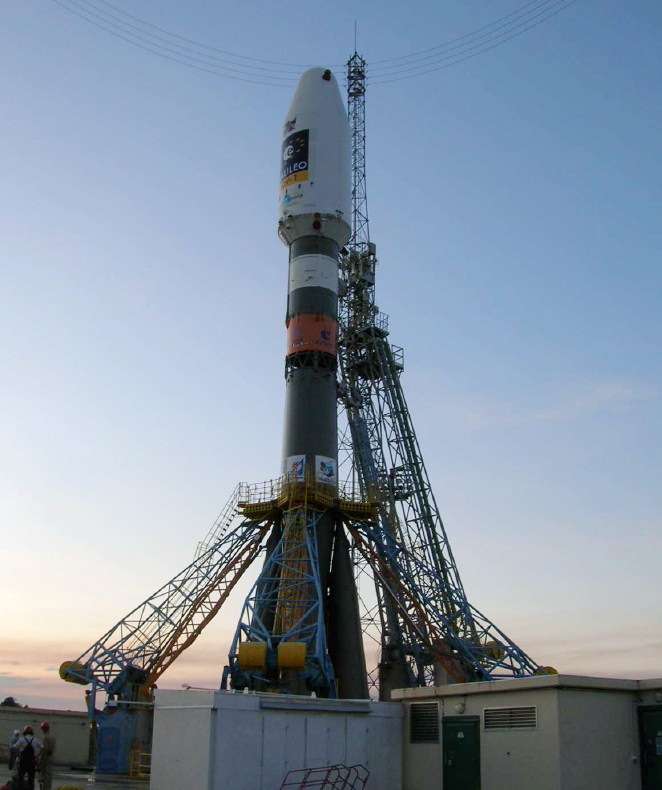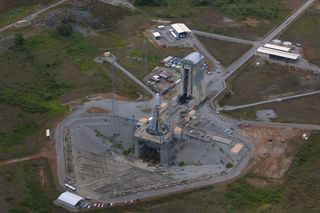
The first operational navigation satellites for a new European GPS system are poised to blast into space Thursday (Oct. 20) atop a Russian rocket that will be making its debut launch from Europe's South American spaceport.
The two satellites, the first of 30 planned in Europe's Galileo constellation, are slated to launch aboard a Russian Soyuz at 6:34 a.m. EDT (1034 GMT) on Thursday. The rocket will lift off from Europe's spaceport in French Guiana, marking the first time a Soyuz has operated outside the old Soviet realm.
This launch comes almost two months after a Soyuz failed while launching the robotic Progress 44 resupply vessel toward the International Space Station on Aug. 24. But the Soyuz blasting off tomorrow is a different model, so there's no reason to fear it could have similar problems, officials with European launch services provider Arianespace have said. [Photos: Russia's Lost Cargo Ship Progress 44]
"The problem that occurred [Aug. 24] is linked to a third-stage motor, and the Soyuz model that we will be using uses a different third stage," Jean-Yves Le Gall, Arianespace president and chief executive, told Agence-France Press (AFP) shortly after the accident. "It is not the same version of the rocket."

A Russian rocket in South America
Since their introduction in the 1960s, Soyuz rockets have launched nearly 1,800 times, flying exclusively out of Russia and Kazakhstan. Thursday's blastoff will thus be the maiden voyage of a Soyuz outside of the former Soviet bloc.
But it won't be the last. Russia and the European Space Agency inked a deal back in 2003 that opens the door to many Soyuz liftoffs from French Guiana. It's a win for both parties: Russia gets more income for its space industry, and Europe gets a workhorse medium-lift rocket. [50 Great Russian Rocket Launch Photos]
Get the Space.com Newsletter
Breaking space news, the latest updates on rocket launches, skywatching events and more!
The result of that deal — and a considerable amount of jungle-clearing and construction since — is the 300-acre (120-hectare) launch site near the town of Kourou. The pad is a faithful replica of the Soyuz launch complexes at Plesetsk in northern Russia and Baikonur in Kazakhstan, experts say.
Arianespace already operates the heavy-lift Ariane 5, which can loft 11 tons to geostationary transfer orbit (GTO). And it plans to start flying the new, much smaller Vega in January 2012.
The Soyuz will slot in between these other two rockets. It will be able to loft about 3.5 tons to GTO from French Guiana — considerably more than the Soyuz can lift from Russia or Kazakhstan, as it will get a major boost from Earth's increased rotational speed near the equator.
A European GPS network
The Soyuz will deposit the two Galileo satellites, each of which weighs about 1,540 pounds (700 kilograms), into circular orbits 14,430 miles (23,222 kilometers) above Earth's surface.
These two pioneers will be joined by 28 other craft over the next several years. (The U.S.'s GPS network currently relies on 24 satellites). The $7.2 billion Galileo constellation will begin offering some services in 2014 and should become fully operational by 2020, officials have said.
The goal of Galileo is to make Europe less reliant on other nations for satellite navigation, which has become a vital part of modern life.
"Galileo springs from a European desire to be independent in geo-location with respect to America's GPS and Russia's Glonass" systems, Claude Audouy of France's National Center of Space Studies told AFP.
When it's fully up and running, Galileo should provide location fixes with a precision as good as 3 feet (1 meter), European Union officials have said. GPS is currently accurate only to about 10 feet (3 m) or so.
Like Europe, China is working to field its own satellite-navigation system. China has already launched several components of its Beidou ("Compass") constellation and hopes the system can provide global coverage by 2020.
You can follow SPACE.com senior writer Mike Wall on Twitter: @michaeldwall. Follow SPACE.com for the latest in space science and exploration news on Twitter @Spacedotcom and on Facebook.
Join our Space Forums to keep talking space on the latest missions, night sky and more! And if you have a news tip, correction or comment, let us know at: community@space.com.

Michael Wall is a Senior Space Writer with Space.com and joined the team in 2010. He primarily covers exoplanets, spaceflight and military space, but has been known to dabble in the space art beat. His book about the search for alien life, "Out There," was published on Nov. 13, 2018. Before becoming a science writer, Michael worked as a herpetologist and wildlife biologist. He has a Ph.D. in evolutionary biology from the University of Sydney, Australia, a bachelor's degree from the University of Arizona, and a graduate certificate in science writing from the University of California, Santa Cruz. To find out what his latest project is, you can follow Michael on Twitter.